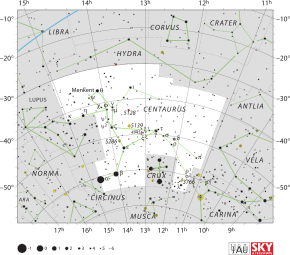| Constellation | |
 | |
| Abbreviation | Cen |
|---|---|
| Genitive | Centauri |
| Pronunciation | /sɛnˈtɔːrəs, -ˈtɑːr-/, genitive /sɛnˈtɔːraɪ, -ˈtɔːri, -ˈtɑːri/ |
| Symbolism | the Centaur |
| Right ascension | 11h 05m 20.9415s–15h 03m 11.1071s[1] |
| Declination | −29.9948788°–−64.6957885°[1] |
| Area | 1060 sq. deg. (9th) |
| Main stars | 11 |
| Bayer/Flamsteed stars | 69 |
| Stars with planets | 15 |
| Stars brighter than 3.00m | 10 |
| Stars within 10.00 pc (32.62 ly) | 8 |
| Brightest star | α Cen (−0.27m) |
| Messier objects | 0 |
| Meteor showers | Alpha Centaurids Omicron Centaurids Theta Centaurids |
| Bordering constellations | Antlia Carina Circinus Crux Hydra Libra (corner) Lupus Musca Vela |
| Visible at latitudes between +25° and −90°. Best visible at 21:00 (9 p.m.) during the month of May. | |
Centaurus /sɛnˈtɔːrəs, -ˈtɑːr-/ is a bright constellation in the southern sky. One of the largest constellations, Centaurus was included among the 48 constellations listed by the 2nd-century astronomer Ptolemy, and it remains one of the 88 modern constellations. In Greek mythology, Centaurus represents a centaur; a creature that is half human, half horse (another constellation named after a centaur is one from the zodiac: Sagittarius). Notable stars include Alpha Centauri, the nearest star system to the Solar System, its neighbour in the sky Beta Centauri, and HR 5171, one of the largest stars yet discovered. The constellation also contains Omega Centauri, the brightest globular cluster as visible from Earth and the largest identified in the Milky Way, possibly a remnant of a dwarf galaxy.
- ^ a b "Centaurus, constellation boundary". The Constellations. Retrieved 15 February 2014.